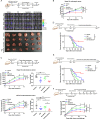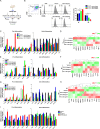Compound kushen injection relieves tumor-associated macrophage-mediated immunosuppression through TNFR1 and sensitizes hepatocellular carcinoma to sorafenib
- PMID: 32179631
- PMCID: PMC7073790
- DOI: 10.1136/jitc-2019-000317
Compound kushen injection relieves tumor-associated macrophage-mediated immunosuppression through TNFR1 and sensitizes hepatocellular carcinoma to sorafenib
Erratum in
-
Correction: Compound kushen injection relieves tumor-associated macrophage-mediated immunosuppression through TNFR1 and sensitizes hepatocellular carcinoma to sorafenib.J Immunother Cancer. 2020 Apr;8(1):e000317corr1. doi: 10.1136/jitc-2019-000317corr1. J Immunother Cancer. 2020. PMID: 32276992 Free PMC article. No abstract available.
Abstract
Background: There is an urgent need for effective treatments for hepatocellular carcinoma (HCC). Immunotherapy is promising especially when combined with traditional therapies. This study aimed to investigate the immunomodulatory function of an approved Chinese medicine formula, compound kushen injection (CKI), and its anti-HCC efficiency in combination with low-dose sorafenib.
Methods: Growth of two murine HCC cells was evaluated in an orthotopic model, a subcutaneous model, two postsurgical recurrence model, and a tumor rechallenge model with CKI and low-dose sorafenib combination treatment. In vivo macrophage or CD8+ T cell depletion and in vitro primary cell coculture models were used to determine the regulation of CKI on macrophages and CD8+ T cells.
Results: CKI significantly enhanced the anticancer activity of sorafenib at a subclinical dose with no obvious side effects. CKI and sorafenib combination treatment prevented the postsurgical recurrence and rechallenged tumor growth. Further, we showed that CKI activated proinflammatory responses and relieved immunosuppression of tumor-associated macrophages in the HCC microenvironment by triggering tumor necrosis factor receptor superfamily member 1 (TNFR1)-mediated NF-κB and p38 MAPK signaling cascades. CKI-primed macrophages significantly promoted the proliferation and the cytotoxic ability of CD8+ T cells and decreased the exhaustion, which subsequently resulted in apoptosis of HCC cells.
Conclusions: CKI acts on macrophages and CD8+ T cells to reshape the immune microenvironment of HCC, which improves the therapeutic outcomes of low-dose sorafenib and avoids adverse chemotherapy effects. Our study shows that traditional Chinese medicines with immunomodulatory properties can potentiate chemotherapeutic drugs and provide a promising approach for HCC treatment.
Keywords: gastroenterology; immunology; pharmacology; tumours.
© Author(s) (or their employer(s)) 2020. Re-use permitted under CC BY-NC. No commercial re-use. See rights and permissions. Published by BMJ.
Conflict of interest statement
Competing interests: None declared.
Figures







Similar articles
-
Autocrine and paracrine LIF signals to collaborate sorafenib-resistance in hepatocellular carcinoma and effects of Kanglaite Injection.Phytomedicine. 2025 Jan;136:156262. doi: 10.1016/j.phymed.2024.156262. Epub 2024 Nov 15. Phytomedicine. 2025. PMID: 39580996
-
A Natural CCR2 Antagonist Relieves Tumor-associated Macrophage-mediated Immunosuppression to Produce a Therapeutic Effect for Liver Cancer.EBioMedicine. 2017 Aug;22:58-67. doi: 10.1016/j.ebiom.2017.07.014. Epub 2017 Jul 18. EBioMedicine. 2017. PMID: 28754304 Free PMC article.
-
Sorafenib relieves cell-intrinsic and cell-extrinsic inhibitions of effector T cells in tumor microenvironment to augment antitumor immunity.Int J Cancer. 2014 Jan 15;134(2):319-31. doi: 10.1002/ijc.28362. Epub 2013 Jul 30. Int J Cancer. 2014. PMID: 23818246
-
The role of tumor-associated macrophages in primary hepatocellular carcinoma and its related targeting therapy.Int J Med Sci. 2021 Mar 15;18(10):2109-2116. doi: 10.7150/ijms.56003. eCollection 2021. Int J Med Sci. 2021. PMID: 33859517 Free PMC article. Review.
-
Burning down the house: Pyroptosis in the tumor microenvironment of hepatocellular carcinoma.Life Sci. 2024 Jun 15;347:122627. doi: 10.1016/j.lfs.2024.122627. Epub 2024 Apr 16. Life Sci. 2024. PMID: 38614301 Review.
Cited by
-
Mesoporous silica nanoparticles inflame tumors to overcome anti-PD-1 resistance through TLR4-NFκB axis.J Immunother Cancer. 2021 Jun;9(6):e002508. doi: 10.1136/jitc-2021-002508. J Immunother Cancer. 2021. PMID: 34117115 Free PMC article.
-
Tumor-Associated Macrophages in Hepatocellular Carcinoma: Friend or Foe?Gut Liver. 2021 Jul 15;15(4):500-516. doi: 10.5009/gnl20223. Gut Liver. 2021. PMID: 33087588 Free PMC article. Review.
-
Targeting tumor-associated macrophages in hepatocellular carcinoma: biology, strategy, and immunotherapy.Cell Death Discov. 2023 Feb 15;9(1):65. doi: 10.1038/s41420-023-01356-7. Cell Death Discov. 2023. PMID: 36792608 Free PMC article. Review.
-
An Advanced Systems Pharmacology Strategy Reveals AKR1B1, MMP2, PTGER3 as Key Genes in the Competing Endogenous RNA Network of Compound Kushen Injection Treating Gastric Carcinoma by Integrated Bioinformatics and Experimental Verification.Front Cell Dev Biol. 2021 Sep 27;9:742421. doi: 10.3389/fcell.2021.742421. eCollection 2021. Front Cell Dev Biol. 2021. PMID: 34646828 Free PMC article.
-
Immune regulation and clinical response of Chinese herbal injections combined with TACE in hepatocellular carcinoma: a cumulative logit regression and Bayesian network meta-analysis.Front Med (Lausanne). 2025 Apr 4;12:1567137. doi: 10.3389/fmed.2025.1567137. eCollection 2025. Front Med (Lausanne). 2025. PMID: 40255589 Free PMC article.
References
Publication types
MeSH terms
Substances
LinkOut - more resources
Full Text Sources
Research Materials
